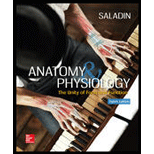
To discuss:
The special route and effect of pain signals that involve the reticular formation; how responses to these signals differ from other responses to pain.
Introduction:
Somatosensory signals like facial sensations (from head) reach the pons and medulla oblongata through various cranial nerves. The first-order nerve fibers of these somatosensory neurons synapse with the second-order neurons in the brainstem. Most of these neurons (second-order somatosensory) synapse with the third order in the contralateral thalamus. The third-order somatosensory neurons complete the pathway to the brain (cerebrum). The second-order nerve fibers carry the proprioceptive signals (from head) to the cerebellum.
Want to see the full answer?
Check out a sample textbook solution
Chapter 16 Solutions
Anatomy & Physiology: The Unity of Form and Function
- In the simplest kind of reflex______, directly signal ________, which act on muscle cells. a. sensory neurons; interneurons b. interneurons; motor neurons c. sensory neurons; motor neurons d. motor neurons; sensory neuronsarrow_forwardThe part of the brain responsible for our conscious mind white matter the cerebral cortex The thalamus the cerebellumarrow_forwardThree principal divisions of the brain, how definitions of brainstem vary, and the definition used in this bookarrow_forward
- How one action potential triggers another; how the continuous conduction seen in unmyelinated nerve fibers result from a chain reaction of action potentials; and what normally prevents the signal from traveling backward to the neurosoma.arrow_forwardHow the human sense organs operate to sense foodarrow_forwardit is not amygdalaarrow_forward
- How autonomic efferent pathways differ from somatic efferent pathways; the meanings of preganglionic and postganglionic fibers .arrow_forwardThe two-element sensory receptors differ from other types of receptors in being:-a- more numerousb- more widely spread in the bodyc- more sensitived- composed of specialized cells at the sensory nerve terminalsarrow_forwardThe most finely detailed vision occurs when an image falls on a pit in the retina called the _________.arrow_forward
 Human Biology (MindTap Course List)BiologyISBN:9781305112100Author:Cecie Starr, Beverly McMillanPublisher:Cengage Learning
Human Biology (MindTap Course List)BiologyISBN:9781305112100Author:Cecie Starr, Beverly McMillanPublisher:Cengage Learning

